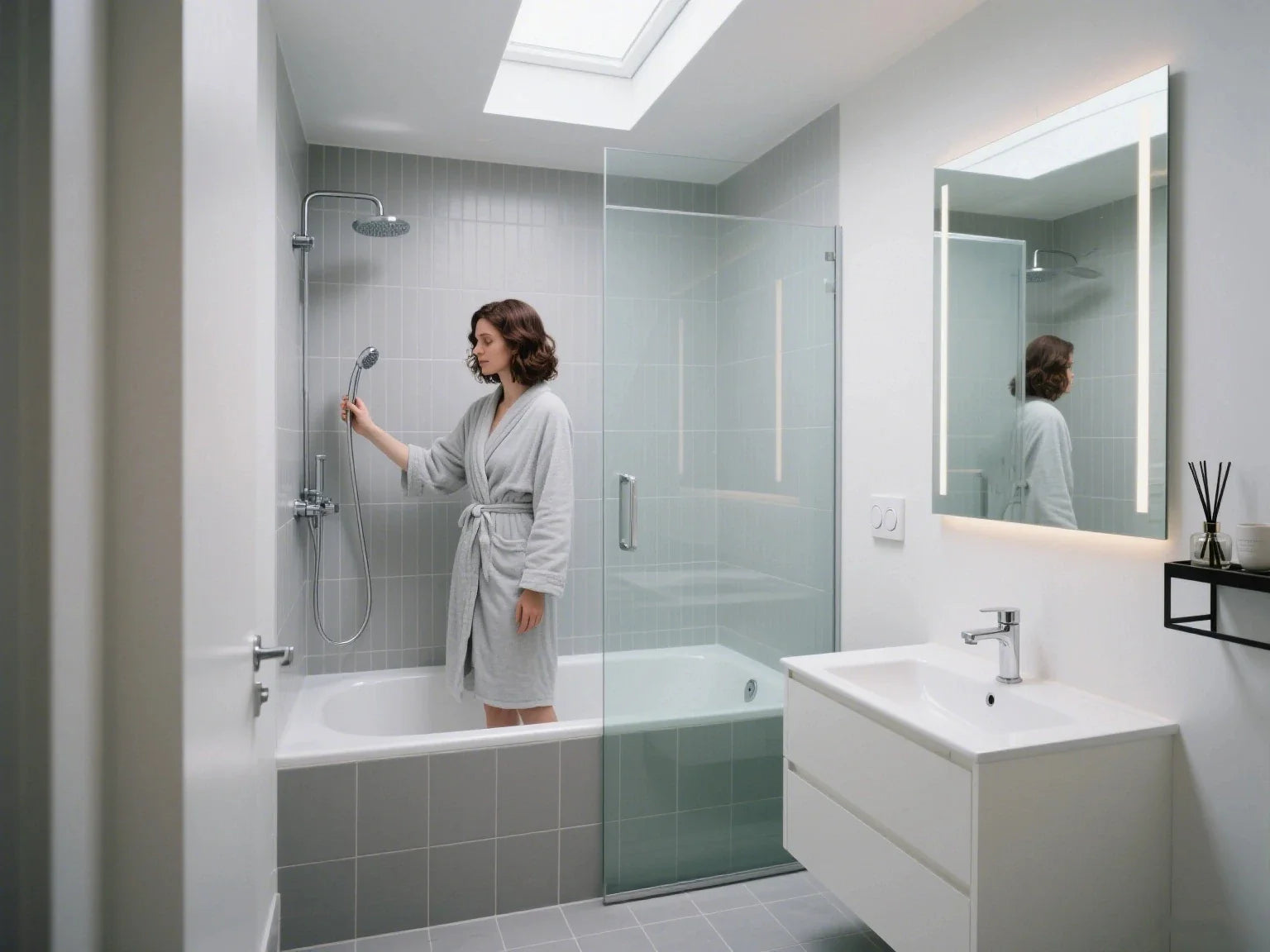Tub Drain Size (Quick Answer)
What is the standard tub drain size?
- 1.5 inches (1 1/2") is the standard drain size for most residential bathtubs. This drain size is common in many modern homes and aligns with plumbing practices and local codes.
- Overflow drains are commonly 1.5 inches as well.
- Source basis: major manufacturers, trade guides, and common U.S. plumbing codes.
When is a 2-inch tub drain recommended?
- Whirlpool, jetted, deep soaking, and some freestanding or walk-in tubs often specify 2 inches to move larger water volumes faster.
- Some accessibility-focused walk-in tubs use dual 2-inch drains to empty quickly for user comfort and safety. Drain openings vary in size depending on the tub capacity, style, and intended use.
- Consider 2 inches if the tub capacity is high; whether you need it depends on the size and on whether the waste line, trap, and vent are sized to support it.
Are there smaller drains (1 3/8 inches)?
- Antique and some clawfoot tubs may have 1 3/8-inch openings, which are slightly smaller than a standard 1.5-inch drain.
- These are less common and often need specialty drain assemblies or adapters.
Can I install a 2-inch drain on a 1.5-inch tub or pipe?
No. Upsizing a drain that doesn't match the tub's drain opening or waste line leads to sealing problems and may violate code.
Solutions:
- Match the drain to both the tub opening and the pipe diameter, or
- Re-pipe to 2 inches (with permits and code checks) if upsizing is necessary and allowed.
Drain Assembly Basics: Parts, Sizing, and How They Interact
What makes up a bathtub drain assembly?
- Drain flange/strainer (the visible ring and grate at the tub floor)
- Drain shoe (fitting under the tub that connects the flange to the waste pipe)
- Waste pipe (runs from the shoe to the tee)
- Overflow cover, gasket, and tube (captures excess water at the tub wall)
- Waste-and-overflow tee (joins the drain and overflow into one line)
- P-trap (water seal that blocks sewer gases)

Drain opening vs. drain pipe diameter (don't confuse them)
- Drain opening: The hole in the tub floor where the flange sits. Measure across the hole, not including the visible flange.
- Pipe diameter (bathtub drain pipe size): The size of the waste line under the tub (commonly 1.5 inches, sometimes 2 inches for high-capacity tubs).
- Both must match your drain assembly.
Overflow drains and depth considerations
Most overflows are 1.5 inches and tie into the waste line at a tee.
Measure:
- Overflow height and center-to-center distance from the drain
- Tub wall thickness (affects gasket compression and hardware reach)
- Distance to the tee (many kits allow adjustable lengths between 14 and 20 inches, but measure to be sure)
Materials, finishes, and durability
Finishes: Chrome, brushed nickel, brass, matte black, and others
Materials:
- Brass bodies and fittings last long and handle heat well
- PVC/ABS are common for waste lines; they're light, easy to cut, and cost-effective
Verify that materials match (e.g., ABS to ABS) or use approved transition fittings as allowed by code.
Step-by-Step: How to Accurately Measure the Size of Your Tub Drain
Measure the tub's drain opening (topside)
- Remove the stopper if present.
- Measure across the drain hole at the tub floor and record the diameter of the drain. Do not include the flange.
- Check for roundness. Older tubs may be out-of-round, which may need wider gaskets or a specialty kit.
- Note the stopper type (toe-touch, lift-and-turn, trip lever), which affects compatibility.
Confirm the drain pipe diameter (underside)
- If you have access from a basement or crawlspace, measure the outside diameter of the pipe and identify the material (PVC, ABS, copper, brass).
- Typical sizes: 1.5 inches on standard tubs; 2 inches on large or specialty tubs.
- Knowing the right bathtub drain and matching the assembly to the pipe size ensures a proper seal and prevents leaks and code issues
Check overflow dimensions and alignment
- Measure the center-to-center distance between the floor drain opening and the overflow hole, because the distance connects the overflow drain and tub drain holes. The fit and tub drain hole will determine the size of the components needed.
- Also measure tub wall thickness at the overflow to choose the right gasket and screws.
- Confirm the overflow inlet height and make sure the tube and tee can reach without stress.
- Double-check the tub and the distance between the drain and overflow to confirm the drain length is sufficient for proper installation without stress.
Use manuals and spec sheets to validate
- Cross-check your numbers with manufacturer specs and bathtub drain specifications for your tub or drain kit.
- Whether installing a new bathtub or replacing an old drain, read the new tub's installation guide before you buy the drain kit.
Choosing the Right Drain by Tub Type and Use-Case
Standard alcove and drop-in bathtubs
Typical recommendation: 1.5-inch drain and overflow
Why it works:
- Fits most existing 1.5-inch waste lines
- Meets common code in many areas
- Easy to source and install
Example: Most modern U.S. alcove tubs use 1.5 inches for both drain and overflow.
Freestanding and clawfoot tubs
Freestanding tubs: A freestanding tub drain is often 1.5 inches; larger premium models may specify 2 inches. Always check specs.
Clawfoot/antique tubs:
- may have 1 3/8-inch openings or custom hole spacing
- often require a specific drain kit with finish-matched exposed hardware
Pay attention to:
- Floor drain location and vertical height
- Exposed finishes and trap style (for appearance and cleaning)

Whirlpool, jetted, and deep soaking tubs
- Faster drain time
- Less waiting before re-entry or cleaning
- Can reduce strain on pump seals by not holding water longer than needed
- Waste line size and trap at 2 inches
- Vent sizing per code
- Access for service
Walk-in and accessible bathtubs
Many walk-in tubs use 1.5-inch drains, but some have dual 2-inch outlets for rapid emptying.
Why it matters:
- Users often must wait for the water when the tub drains to clear before exiting
- Faster drainage improves safety and comfort
Verify:
- Number of outlets and the tee configuration
- Overflow height and gasket compression
- Pipe routing and venting
Installation Fit, Upgrades, and Troubleshooting
Common sizing mistakes to avoid
- Measuring the flange instead of the drain opening
- Ignoring the pipe diameter beneath the tub
- Mismatching overflow depth and center-to-center distance
- Mixing metric and imperial parts
- Assuming "universal" kits fit every tub
- Overlooking tub wall thickness at the overflow
- Not checking waste-and-overflow length (many are adjustable within a range, like 14–20 inches)
What to do when the new drain doesn't fit
If too large or small:
- Exchange for the correct size; look for a drain to fit the opening
- Use a manufacturer-approved adapter only if listed as compatible
For irregular or antique openings:
- Use specialty or custom assemblies and choose from different drain features that match your tub type
- Avoid DIY stacks of odd gaskets or sealants as they often leak
If threads or sealing surfaces don't match:
- Verify thread spec and gasket type
- Keep sealing surfaces clean and dry before assembly
Upgrading from 1.5-inch to 2-inch drains
Upgrading or installing a bathtub sized drain ensures proper flow, correct trap sealing, and prevents leaks. It usually requires changing:
- The waste line, P-trap, and possibly the trap arm
Check:
- Local code and permits
- Venting adequacy
- Structural access for pipe routing
Often best handled by a licensed plumber.
Signs your drain size is incorrect (and fixes)
- Chronic slow drainage: Check for mismatched size, poor slope, or venting issues. Clear clogs and verify trap size.
- Gurgling: May indicate venting problems; confirm vent connection and size.
- Leaks at the flange or overflow: Check gasket compression, alignment, and that the assembly matches the opening size — if not addressed, the tub is at risk.
- Frequent clogs: Make sure the trap size and drain line match the fixture, and use a strainer to catch hair.

Plumbing Codes, Permits, and Regional Differences
US code basics for tub drains
- Many jurisdictions require a minimum 1.5-inch trap and fixture drain for bathtubs.
- Overflows typically match at 1.5 inches.
- Code is adopted locally; always confirm with your authority having jurisdiction (AHJ).
- Fixture trap must match the fixture drain and must not be smaller than the outlet of the fixture.
- Trap seals and venting must follow local code to prevent sewer gas and ensure proper flow.
Local code checks and permits
- Simple like-for-like drain replacements often do not need a permit.
- Re-piping, upsizing, or changing the vent usually requires a permit and inspection.
- Contact your local building department before you start.
International and older-home considerations
- Older homes or international installs may use non-standard sizes or metric components.
- Plan for adapters or custom drains and verify thread patterns and gasket types.
- Codes outside the US may have different trap and vent rules.
Do I need a permit to replace a tub drain?
- Often no — you can replace a tub drain without a permit when it's a like-for-like swap, but yes for size changes, re-routing, or vent changes.
- Always check with your local building department.
Performance, Cost, and Time: Does Size Matter?
Cost comparison: 1.5-inch vs 2-inch assemblies
- 1.5-inch kits: Widely available, lower cost, broad finish options.
- 2-inch kits: Often pricier, can be limited in finish choices, and may require more labor if you must re-pipe.
- Upgrading pipe size increases labor and material costs and may require permits.
Drain time and user experience
- Larger drains move the water to drain faster from high-volume tubs.
- For walk-in tubs, drain time can affect comfort and safety. Dual 2-inch drains in some models can cut wait times.
- For standard alcove tubs, a 1.5-inch drain usually empties the tub in a few minutes, depending on trap, venting, and pipe run.

DIY vs pro installation
DIY-friendly if you have clear access, parts match, and no re-piping.
Consider a licensed plumber if:
- You need re-piping or upsizing
- You have old galvanized or brass lines to replace
- You face venting or slope correction
How long should a bathtub take to drain?
- A standard alcove tub with a 1.5-inch drain should drain in a few minutes, depending on water volume and plumbing layout.
- High-capacity tubs can take much longer by 1.5 inches. A 2-inch system helps reduce wait time.
Real-World Scenarios and Case Studies
Standard alcove remodel with existing 1.5-inch line
- Action: Matched 1.5-inch drain/overflow; confirmed gasket seals; upgraded the stopper style.
- Result: Code-compliant, low-cost, quick install, clean look.
Vintage clawfoot with non-standard opening
- Action: Measured a 1 3/8-inch opening; ordered a specialty drain with finish-matched exposed hardware.
- Lessons: Careful measuring and confirming part specs prevent leaks and returns.
Deep soaking tub retrofitted in a primary suite
- Action: Upgraded to a 2-inch drain and re-piped the waste line; verified vent size; pulled a permit.
- Outcome: Faster drain time and higher user satisfaction.
Walk-in tub with dual 2-inch drains
- Action: Routed dual outlets to a 2-inch waste system for rapid emptying; verified overflow height and gasket compression.
- Importance: Critical for accessibility, comfort, and safety.
Myths, and Pro Tips
- Use a strainer to catch hair
- Avoid pouring grease or waxes down the drain
- Clean the stopper, flange, drain, and surrounding area regularly, and occasionally use a drain cleaner to prevent buildup
- Ensure proper venting to reduce gurgling
Tools, and Resources to Include
Interactive tools
- Yes → 1.5 inches
- Yes → Check specs; many call for 2 inches. If upsizing, confirm pipe, trap, and vent are 2 inches and code-approved.
Quick-reference tables
| Tub Type | Typical Drain Size | Overflow Size | Notes |
| Standard Alcove | 1.5 in | 1.5 in | Broad compatibility; meets many codes |
| Drop-In | 1.5 in | 1.5 in | Similar to alcove; easy retrofit |
| Freestanding | 1.5–2 in | 1.5 in | Verify specs on large or premium models |
| Whirlpool/Jetted | 2 in | 1.5 in | Faster drainage for large volume |
| Deep Soaking | 2 in | 1.5 in | Consider upgrade for user comfort |
| Walk-In | 1.5–2 in (some dual 2 in) | 1.5 in | Some models use dual drains for fast emptying |
| Clawfoot/Antique | 1 3/8–1.5 in | 1.5 in | May require specialty kits |
| Step | What to Measure | Target/Tip | Common Mistake |
| 1 | Drain opening (topside) | Measure hole only, not flange | Measuring the flange diameter |
| 2 | Pipe diameter (underside) | Identify 1.5 in or 2 in | Guessing pipe size from above |
| 3 | Overflow center height | Center-to-center to drain | Ignoring mismatch to tee length |
| 4 | Wall thickness at overflow | Choose correct gasket | Over-compressing thin gaskets |
| 5 | Waste-to-tee length | Many kits adjust ~14–20 in | Assuming all "universal" kits fit |
| 6 | Stopper type | Toe-touch/lift-and-turn/trip lever | Ordering a stopper that doesn't fit |
Measurement & Installation at A Glance
How to Measure the Size of Your Bathtub
- Use a tape measure to measure the drain opening across the hole, not the flange.
- Check the drain pipe under the tub; write down 1.5 inches or 2 inches and the material.
- Measure the length between the drain and overflow centers; many kits allow you to cut them to size within a range.
- Confirm tub wall thickness and overflow gasket type.
- Match all parts in the drain and overflow kit to your measurements.
How to Set Up and Install Bathtub Drain Plumbing (Basics)
- Dry-fit the drain shoe and flange through the opening. Use the correct gasket.
- Install the overflow gasket and cover at the right height; do not overtighten.
- Adjust or cut the waste-and-overflow tubes to match your distance from the tub drain to the overflow, ensuring the drain shoe length fits properly, and from the tee to the trap.
- Use approved primer and cement for plastic pipes, or proper thread sealant for threaded brass.
- Connect to a properly sized, vented P-trap and drain pipe.
- Test for leaks before closing walls or panels.
Choosing the Right Bathtub Drain Size (At a Glance)
- Standard alcove or drop-in tub? Choose 1.5 inches.
- Large soaking, whirlpool, or jetted tub? Check the specs, which are often 2 inches in size.
- Antique or clawfoot? Measure carefully; 1 3/8 inches may apply.
- Freestanding? Many are 1.5 inches, but verify the model; some are 2 inches.
- Walk-in tub? Could be 1.5 inches, 2 inches, or dual 2 inches.
Internal Project Tips and Safety Checks
- Sometimes your bathroom may have an access panel behind the tub; use it to measure and inspect the existing tub drain.
- Confirm your vent location. Poor venting makes even a correctly sized drain gurgle and drain slowly.
- If the size of the tub is very large, you may require a larger drain and line to help drain the tub quickly.
- The distance between the drain and overflow affects which kit you buy. Kits often state their adjustable length between the drain and overflow (such as 14–20 inches).
- If replacing an old drain, check for corrosion, out-of-round holes, or damaged enamel that could prevent a seal.
Closing Summary
FAQs
1. Is a bathtub drain 1.5 or 2 inches?
2. What size is the P-trap for a bathtub?
3. What size is a bathtub drain pipe?
4. What kind of drain for a freestanding tub?
5. How do you measure a tub drain size?
- To accurately measure a bathtub drain, first measure the drain hole (not the flange) to determine the actual drain diameter.
- Next, measure the diameter of the pipe beneath the tub, which is crucial for matching the drain components.
- Also consider the distance from the drain opening to the overflow, as it impacts the design and installation of the drainage system.
- Finally, consider the tub wall thickness, which influences the type of drain component required, especially for deeper or thicker tubs.








Leave a comment
This site is protected by hCaptcha and the hCaptcha Privacy Policy and Terms of Service apply.